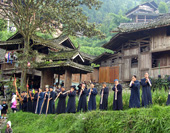
Miao Village Guide
-Travel to Miao Village The Miao people have lived in the eastern part of present day Guizhou and western part of present day Hunan for over 2,000 years. Since the Tang and Song periods they have been referred to as the Miao minority. The Miao people have one of the largest populations out of all the ethnic minorities in southern China, with more than 9,000,000 people. They live mainly in Sichuan, Hunan, Guizhou, Yunnan and Guangxi provinces and autonomous regions. A small number of the Miao people also live on Hainan Island and in Guangdong Province. Many of them form tight-knit communities wherever they live.
The Miao people have lived in the eastern part of present day Guizhou and western part of present day Hunan for over 2,000 years. Since the Tang and Song periods they have been referred to as the Miao minority. The Miao people have one of the largest populations out of all the ethnic minorities in southern China, with more than 9,000,000 people. They live mainly in Sichuan, Hunan, Guizhou, Yunnan and Guangxi provinces and autonomous regions. A small number of the Miao people also live on Hainan Island and in Guangdong Province. Many of them form tight-knit communities wherever they live.
 Throughout several centuries, the Miao have been moving to different areas of the country. In the 3rd century they went to south Sichuan and northwestern Guizhou; in the 5th century they migrated to western Guizhou and eastern Sichuan; in the 9th century they were taken to Yunnan as slaves and in the 16th century they settled in Hainan Island. The Miao culture is very unique and diversified but all came from one common root. They are especially known for singing and dancing and are very popular amongst themselves and other Chinese. The Miao are exceptionally good at playing the lusheng as well as the copper drum, flutes and several other instruments. Their most popular dances are the drum dance, lusheng dance and the bench dance.
Throughout several centuries, the Miao have been moving to different areas of the country. In the 3rd century they went to south Sichuan and northwestern Guizhou; in the 5th century they migrated to western Guizhou and eastern Sichuan; in the 9th century they were taken to Yunnan as slaves and in the 16th century they settled in Hainan Island. The Miao culture is very unique and diversified but all came from one common root. They are especially known for singing and dancing and are very popular amongst themselves and other Chinese. The Miao are exceptionally good at playing the lusheng as well as the copper drum, flutes and several other instruments. Their most popular dances are the drum dance, lusheng dance and the bench dance.
Basha people belong to the Miao branch that is least affected by modern civilization. Even in the modern times, they still live very traditional lives. As an old saying goes, "men till and women weave." The local villagers' ethnic costumes that are made and dyed (mostly in glazing deep blue) in the traditional way, tend to bring visitors back in time to hundreds of years ago, with the visitors believing they have returned to an ancient tribe. Basha people consider themselves the most orthodox Miao group. Formerly, when the young people returned from other places, they had to change their clothes into those of their own ethnic group right outside the village. Otherwise, they were not allowed to enter the village. Where antiquated wooden spinning wheels and looms can be found here and there.
More Attractions in Guizhou Province
Your Question & Quick Answer*We welcome and appreciate your questions & reviews
Booking Procedures | Terms & Conditions | Payment Methods | Links | Site Map | About Us | Contact Us | Travel Agent
Copyright 2008, All rights reserved.. itourbeijing.com professional china travel guide and china travel service
TEL: 86-10-85711972 (Universal) 1-888-288-9328 (North America) E-mail: contact@itourbeijng.com
Tours Index | China Tours | Beijing Tours | Xi'an Tours | Shanghai Tours | Guilin Tours | Tibet Tours
China Travel | Beijing Travel | Shanghai Travel | Xi'an Travel | Guilin Travel |Beijing Map
China Golf | Beijing Golf | Shanghai Golf | Xiamen Golf | The Great Wall Travel | Yangtze Cruise | Travel Picture



